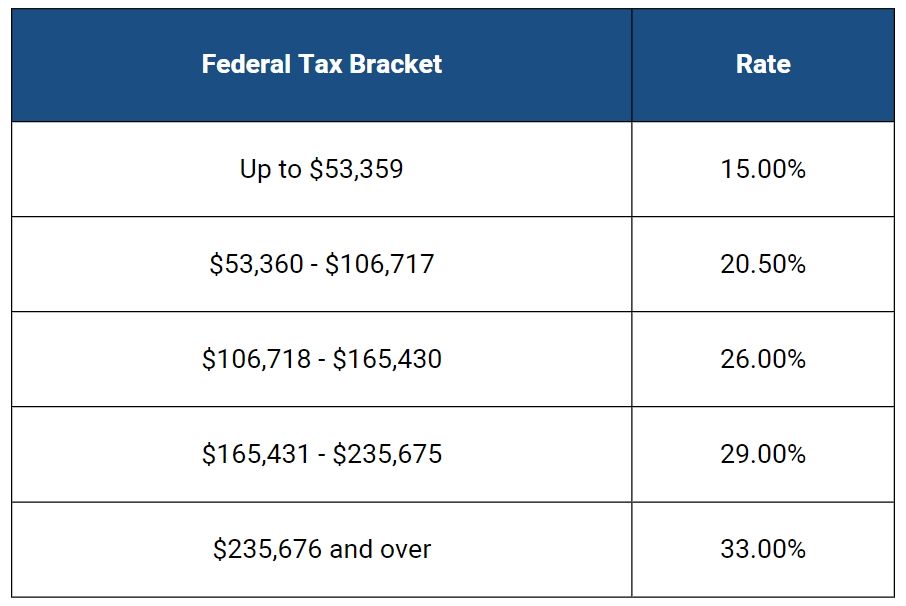Your 101 on How Canadians Are Taxed

Some types of income are more tax efficient than others. If you earn capital gains, only 50% of the gain will be included in your taxable income, while your employment and investment income will be fully taxed. Withdrawals from your RRSP or RRIF are also fully taxable. Dividends receive preferential tax treatment through the use of the dividend gross-up and tax credit. There are two types of dividends: eligible and non-eligible dividends. Non-eligible dividends are taxed at a higher rate than eligible dividends. Usually, dividends you receive in your investment portfolio would be eligible dividends (dividends from publicly traded securities). While preparing your 2023 tax return, review the types of income you earned and evaluate if you should make a change to the types of income you are receiving. However, don’t let the taxation of the income be the only reason for changing an investment. Talk to an Advisor to help match your income to your planning goals.
Certain expenditures are deductible from your income and there are also tax credits available that can reduce your tax liability. The CRA’s website has a page that describes the deductions and tax credits that are available. To be applied to your tax return, the expenses must have been incurred by December 31 of the tax year in question (except for RRSP contributions which can be made 60 days after year end and still reduce the prior year tax liability - so for the 2023 tax year, RRSP contributions can be made up to February 29, 2024). For employees, there are less deductions than for those who are self-employed. The most common deductions are for RRSP contributions, childcare expenses, capital losses and investment related expenses. New for 2023 is the first home savings account (FHSA). The contribution limit for this account is $8,000 and is tax deductible. For more information on how this account works, consult CRA’s First Home Savings Account page . The most common credits are for medical expenses, charitable donations and tuition fees. Of course, there are also ways to save taxes on income in the long-term by investing in a tax-free savings account (TFSA) or registered education savings plan (RESP), for example. While contributions to these types of plans don’t result in a deduction on your tax return, the income earned in the plans are not taxable while in the plan. For TFSA, there is no tax to you on withdrawal. For RESP, the funds are taxed in the hands of the student. The TFSA contribution limit for 2024 is $7,000. If you have not made a TFSA contribution in the past, the contribution room carries forward. For example, if you were 18 years or older in 2009 and have never contributed to a TFSA, you could contribute $95,000 to a TFSA in 2024. For more information on how TFSAs work, read How to Use a TFSA to Get Better Investing Results and for more information RESPs, check out Getting the Most from Your RESP , SMART TALK… about registered education savings plans (RESPs) and this Start Education Planning Now calculator .
Now is also an opportune time to review your overall financial and estate plan which would include your wills, power of attorney and representation agreements, life insurance needs as well as critical illness and disability insurance.
Contact us to learn more or if you have any questions.
The contents of this publication were researched, written and produced by The Link Between (https://www.thelinkbetween.ca/) and are used by Echelon Wealth Partners Inc. for information purposes only.
Disclaimers
Echelon Wealth Partners Inc.
The opinions expressed in this report are the opinions of the author and readers should not assume they reflect the opinions or recommendations of Echelon Wealth Partners Inc. or its affiliates. Assumptions, opinions and estimates constitute the author's judgment as of the date of this material and are subject to change without notice. We do not warrant the completeness or accuracy of this material, and it should not be relied upon as such. Before acting on any recommendation, you should consider whether it is suitable for your particular circumstances and, if necessary, seek professional advice. Past performance is not indicative of future results. The comments contained herein are general in nature and are not intended to be, nor should be construed to be, legal or tax advice to any particular individual. Accordingly, individuals should consult their own legal or tax advisors for advice with respect to the tax consequences to them.



COMMITTED TO SUCCESS
We value the partnership we have with our clients, our employees and our regulators. We see ourselves as partners and that approach has helped us become one of Canada’s leading independent investment dealers.
Ventum Financial Corp. is a licensed broker-dealer operating in all provinces and territories of Canada. We are proud members of the Canadian Investment Regulatory Organization and participate in the Canadian Investor Protection Fund. It is important to note that the content of our website is not intended, and should not be construed, as a solicitation of customers or business in any jurisdiction where we are not registered as a dealer in securities. Our commitment is to operate within the regulatory framework to ensure transparency, protection, and adherence to industry standards.


